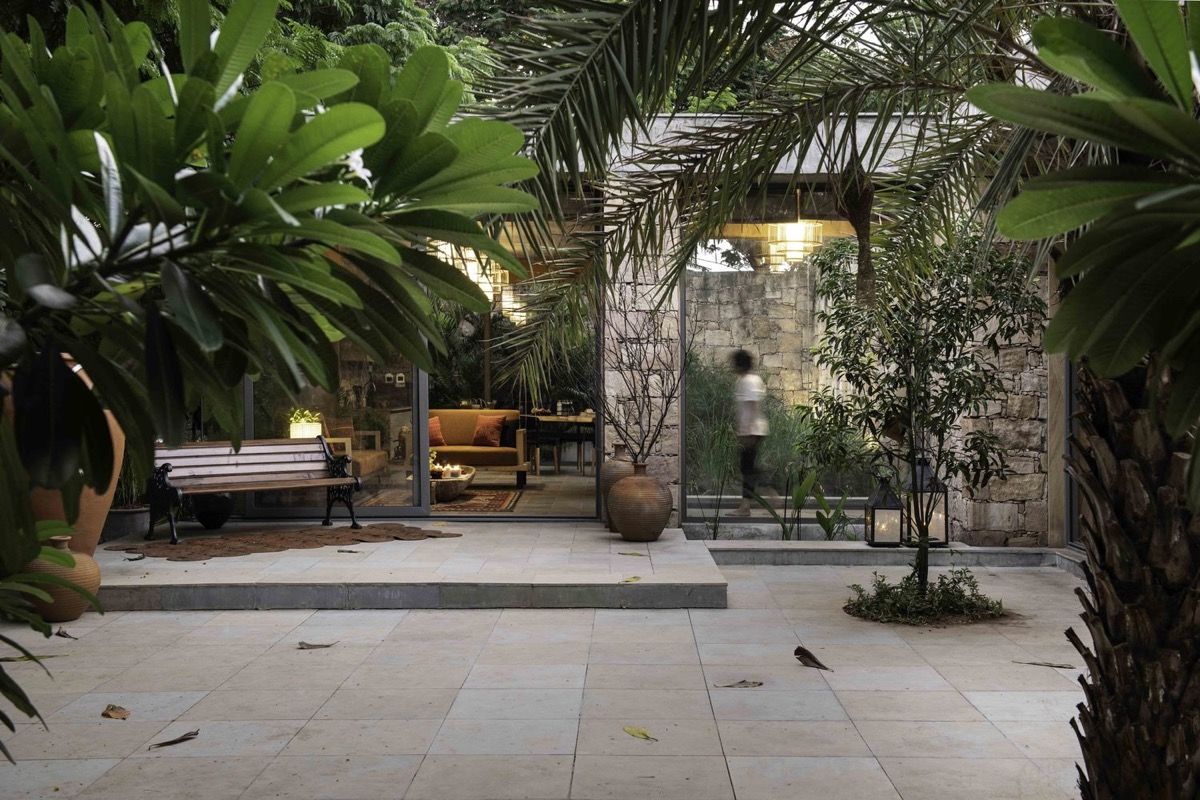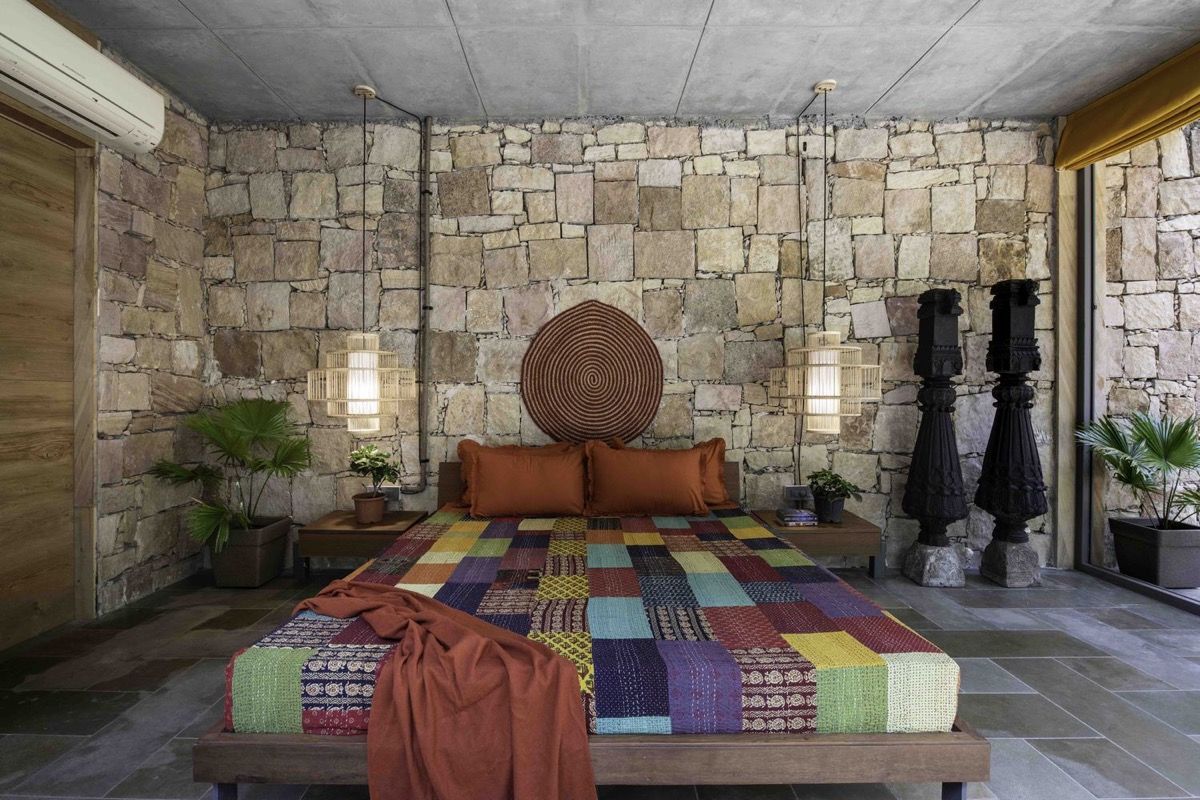Single-story modern rustic home in India, featuring a cosy rustic interior design made with natural materials, reclaimed wood, and a Kotah limestone floor.
Dhrangadhra yellow stone and exposed concrete build this wonderful single-story modern rustic home in Gujarat, Ahmedabad, India. Designed by Snehal Suthar and Bhadri Suthar of tHE gRID Architects, the 1100 square foot home is a single-story dwelling that was created as an intimate, modest weekend getaway. The cosy interior design marks a relationship between manmade and natural materials, featuring beautiful reclaimed wood, jute and rope, mild steel, and entire walls of clear glass. A tonal limestone floor created with Kotah slabs smooths easily onto a paved terrace. These earthy, local materials plus local workmanship meant that the build of the home had a reduced carbon footprint, which was significant to the owner.

The Dhrangadhra yellow stone that was used for both the foundation and overall construction of the home gives the property its name, the Rock House. The 1100 square foot home is situated on a 4776.3 square foot site, which allows for a large terrace to be built alongside the property, where the couple can spend quality time together and entertain friends

The yellow stone construction gives the single-story home its warm, rustic charm. Terracotta planters are scattered around the extensive paved terrace, creating many decorative moments of interest and opportunities for added greenery.

A mature palm tree is bedded right at the centre of the large patio area. The natural surroundings remained largely undisturbed in the building of this ecologically sensitive home.

The holiday homeowners wished to create a place that would pair privacy with open spaces, so that they could connect more with the outdoors. The architects answered this brief with a home design that was built around nature, rather than the incorporation of nature into the home.

The natural and raw materials of the modest home design harmonises with the native environment. The architecture forms an H-shaped block that only very gently impinges upon the native scenery.

The weekend home offers the owners a relaxing, nature kissed experience that is fundamentally different from their routine living during the week. Large local mature trees provide shade from the sun along all the pathways. In lieu of manmade walls, these trees also mark the boundary of the home.

The paved plinth raises the single-story house up by two feet to provide a small vantage point over the green landscape. Plants and water bodies create an independent micro-ecosystem.

The programme and planning minimised the built-form to ensure continual communion with nature.

The house was designed as a mere shelter for some essential daily activities, with the rest of weekend life expected to take place outside.

Local species of insect repellent plants keep the bugs at bay in the outdoor living areas.

Inside the home, the one-foot-thick stone walls remain a prominent design feature. The continuation of yellow stone solidifies the easy connection between the interior and exterior spaces and simply dispenses with cosmetic layering. Red throw pillows and a red rug add bright accents to a cosy lounge area, whilst a modern dining set makes a weatherproof dining spot.

Unique furniture items fill the rustic interior with oodles of character and intriguing talking points.

Great walls of glass maintain links with the lush green environment at all times, even when tucked away indoors.

The rustic bedroom is a wildly colourful retreat with a patchwork bedcover and woven bedroom wall decor. More floor-to-ceiling glazing extends the home’s connection with the gardens, absorbs natural light play, and displays the passing seasons.

Reclaimed wood bedroom pendant lights are situated above understated floating bedside units, which allow the more decorative pieces in the room to shine.

Coordinating wooden pendant lights illuminate the walkways around the home.

Even when spending time indoors to cook food or dine under shelter, the wide glass doors can be drawn back to create an open link with the landscape. The one wall kitchen installation is a raw wood design, which complements the organic envelope of stone walls and tropical plants. Kotah limestone slabs fill the floor of the kitchen diner and flow throughout the rest of the home. An exposed concrete ceiling adds a touch of raw industrial style.

Trees around the property provide shelter and sustenance to local birds and small fauna, encouraging biodiversity.

The architects avoided fragmentation of the landscape with compound walls so that the house would rely on natural boundaries created by vegetation for privacy.

The site plan illustrates how the established trees were maintained to achieve natural privacy. The floor plan shows how the architects created living spaces that are column-free in order to provide unobstructed views of the landscape.

The left side elevation is solid stone, creating a rustic fortress to the outside world. Stone columns smartly mark the veranda.

As we move around to the rear elevation, we observe a stone and glass facade that links the home interior to the natural surroundings.

More floor-to-ceiling glass breaks open the right side elevation of the house.

In section A, we observe a small courtyard just off the bathroom, which gives the room a private garden view.

The main courtyard is a prominent feature in Section B, where it neighbours the living area. A second courtyard flanks the passageway.

Finally, section C lays out the dining area in relation to the lounge, and marks the flow into the large, paved backyard area where the majority of daily life activities take place for the couple every weekend.
Check out the home tour (Videography by Inclined studio):















